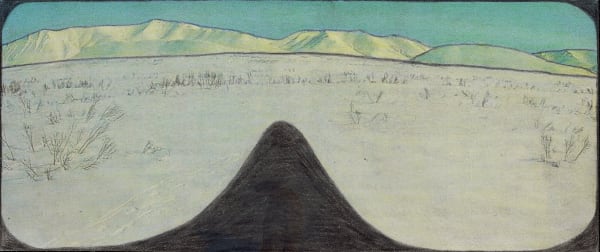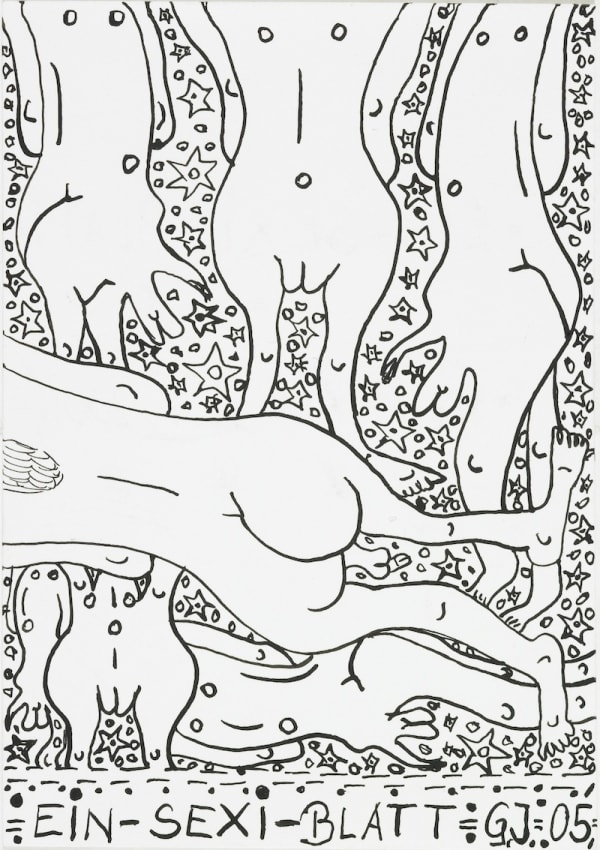Ricco/Maresca Gallery is proud to present gugging: ten days only, a group exhibition featuring 30 works by seven artists created from the 1970s to today at Gugging, Austria’s pioneering cultural hub dedicated to art brut. This exhibition highlights the rich legacy and groundbreaking creativity nurtured at Gugging, an institution that has redefined the boundaries of artistic expression for decades.
Originally a psychiatric hospital, Gugging’s transformation into a beacon for art brut began in 1954 when Dr. Leo Navratil introduced a “draw-a-person” test as a diagnostic tool. He quickly noticed the exceptional quality of drawings by certain patients, sparking his fascination with the relationship between creativity and mental illness. Navratil's book Schizophrenia and Art (1965) captured the attention of avant-garde luminaries like Arnulf Rainer and Peter Pongratz, while Jean Dubuffet, who coined the term art brut to describe raw, unmediated art from outside mainstream culture, heralded works by Gugging’s artists as definitive examples of the movement.
The first public exhibition of Gugging artists in 1970 was a turning point. Determined to provide his artistically inclined patients with better living and working conditions, Navratil established the Centre for Art and Psychotherapy in a nearby building. This initiative, initially met with resistance, flourished, offering the artists a nurturing environment where creativity could thrive. Among the first residents were Johann Korec (1937–1980), whose introspective watercolor and ink pieces combined text and image into a unique visual language, and Johann Garber (b. 1947), celebrated for his paradisiacal ink drawings teeming with fantastical figures and lush detail.
Under the leadership of Dr. Johann Feilacher, who became director in 1986, the institution was renamed the House of Artists, reflecting a shift in philosophy: the “artist-patients” were now recognized simply as artists. Feilacher’s innovative approach, which emphasized direct sales and high-profile exhibitions, elevated Gugging to an international platform, cementing its reputation as a vital contributor to the art brut movement.
Today, Gugging encompasses a museum, gallery, and atelier, welcoming both residents and visiting artists like Leopold Strobl (b. 1960), whose meditative art practice has garnered widespread acclaim. Among the current generation of Gugging artists are Helmut Hladisch (b. 1961), known for his intricate drawings that blend abstraction with representation; Günther Schützenhöfer (b. 1965), whose strikingly original graphite works explore depth and form; and Manuel Griebler (b. 1991), whose kaleidoscopic compositions teem with intricate, densely layered patterns and a vivid interplay of colors. Griebler’s works feature a surreal world populated by whimsical figures that invites viewers into an intricate universe that balances chaos and order.
-
Günther Schützenhöfer
(b. 1965)-
 Sunshade, 2019Graphite on paper27.5 x 19.8 in. (70 x 50 cm.)(GSG 116)
Sunshade, 2019Graphite on paper27.5 x 19.8 in. (70 x 50 cm.)(GSG 116) -
 Locomotive, 2022Graphite and colored pencil on paper27 1/2 x 39 3/8 in. (70 x 100 cm.)(GSG 127)
Locomotive, 2022Graphite and colored pencil on paper27 1/2 x 39 3/8 in. (70 x 100 cm.)(GSG 127) -
 Locomotive, 2016Graphite and colored pencil on paper28 3/8 x 40 1/8 in. (72.2 x 102 cm.)(GSG 128)
Locomotive, 2016Graphite and colored pencil on paper28 3/8 x 40 1/8 in. (72.2 x 102 cm.)(GSG 128) -
 Butterfly, 2017Graphite on paper16.5 x 23.4 in. (42 x 59.5 cm.)(GSG 110)
Butterfly, 2017Graphite on paper16.5 x 23.4 in. (42 x 59.5 cm.)(GSG 110)
-
-
Günther Schützenhöfer was born in Mödling, Austria. As a six-year-old, he arrived at the former Gugging Clinic and spent his life in various care facilities until 1999, when aged 34, he moved into the Gugging House of Artists, where he produced his first drawings. Over the past 15 years, Schützenhöfer has developed a unique, unmistakable style. He portrays elements from his surroundings in an abstracted, self-contained manner, which is joyfully unconcerned with perspective; nearly enigmatic yet always permeated by the artist’s subtle humor.
At first, Schützenhöfer worked very cautiously and mostly in small formats. Over time, the formats have grown larger; fine lines giving way to bold, determined strokes. He works in pencil and colored pencils on paper and cardboard. He sketches out his theme in a few lines, then uses stronger pressure with his pencil to bring it to life. Sometimes this pressure will break the pencil; for this reason, the artist keeps at least five sharpened pencils readily available, and once he has used them all, he will grab any other pencils lying around on the table. This constant change in pencils of different grades and the varying touch he applies, results in idiosyncratic shadings and a soft, almost furry texture.
Schützenhöfer chooses his themes spontaneously, often related to the current season or situation. His approach is entirely focused on the essence, the gist of his theme. Limiting himself to the vital elements, he produces drawings and compositions that are unique in their overall sophistication. Schützenhöfer’s works have been shown worldwide since 2001 and are represented in numerous private and public collections, such as the Lower Austria Regional Collection, the Museum of Everything, the Peter Infeld Private Trust, and the Arnulf Rainer Collection.
-
Johann Korec
(1937 - 2008) -
Johann Korec grew up in orphanages in Vienna and from age thirteen worked as a farm laborer and shepherd. His dream was to care for animals in a circus, but manic depression and hypomania led to his commitment to the Maria Gugging Psychiatric Clinic just north of Vienna in 1958. Only four years earlier, psychiatrist Leo Navratil had administered diagnostic drawing tests to his patients at the clinic, discovering that several of them had artistic talent. Navratil’s first book “Schizophrenia and Art” was published in 1965. In 1970 the Gugging artists had their first exhibition in the Viennese Galerie nächst St. Stephan. By 1981 all artistically talented patients at Gugging (including Korec) were housed under one roof—the Center for Art-Psychotherapy—and exhibitions featuring their work began to appear throughout Europe.Korec’s interest in art emerged in the 1960s, when he started collecting images from print media and tracing the figures that appealed to him. At one point, he began to combine the tracings with his own compositions—retracing all contours with India ink and filling them with watercolors. Narrative is an essential graphic component of each work, a pictorial diary documenting the story unfolding in the artist’s mind.
-
Leopold Strobl
(b. 1960) • All works: Untitled. Graphite and colored pencils on newsprint clip mounted on paper.-

2022
2 7/8 x 3 3/4 in. (7.4 x 9.6 cm)
(LpS 416)
-
 20223 1/2 x 3 5/8 in. (8.8 x 9.2 cm)(LpS 408)
20223 1/2 x 3 5/8 in. (8.8 x 9.2 cm)(LpS 408) -
 20183.1 x 4.5 in. (7.9 x 11.5 cm)(LpS 279)
20183.1 x 4.5 in. (7.9 x 11.5 cm)(LpS 279) -
 20192 1/2 x 5 5/8 in. (6.3 x 14.2 cm.)(LpS 307)
20192 1/2 x 5 5/8 in. (6.3 x 14.2 cm.)(LpS 307)
-
-
Strobl was born in Mistelbach, Lower Austria. He has been devoted to art since his early twenties, but the visual language for which he is known is a relatively recent development--only about six years in the making. Strobl has been a guest of the Open Studio program at the Gugging Art Brut center for more than 16 years. He works almost every day, starting in the early hours of the morning, and completes one drawing daily. This impetus is significant both in terms of form and content: the artist’s works are generally no bigger than 8 ½ inches on the longest side and can be almost as small as a postage stamp; they come to the artist as little visual epiphanies and strike the viewer with this poetic immediacy.
A "classic" Strobl work, elegant in both execution and subject, will feature shrouded figures literally transformed into a graphite topography; lone peaks, sinuous hills, and boulder-like shapes in landscapes overlooked by luminous green-blue skies. The artist is a perceptive colorist and imbues his world with shades green, grey, yellow, blue, and ivory white—blending and layering pigment onto large areas with an eye toward the existing texture and light in the underlying photograph—so that ultimately, we don't know where the artist's touch ends and the found image begins.
Strobl's debut exhibition in the United States took place at Ricco/Maresca Gallery in the spring of 2016. In 2018 the Museum of Modern Art in New York acquired five works by the artist for its permanent collection.
More recently, the artist was included in the 2024 edition of Venice Biennale (April 20 - November 24) as part of the exhibition “Foreigners Everywhere,” curated by Adriano Pedrosa.
-
Johann Garber
(b. 1947) -
Johann Garber began producing work in the late 1970s within the Lower Austrian Psychiatric Hospital in the village of Gugging, outside Vienna, where he was first admitted at age 19. He is a prominent member of the Gugging Artist Group, consisting of long-term psychiatric in-patients at the hospital—chosen by the psychiatrist Dr. Leo Navratil because of their artistic abilities ... Garber’s pictorial obsessions with sex and sexuality were thus allowed to develop into a sustained art practice ... [He] gives his erotic drawings the generic name “Sexi-Blatt” (Sexy Sheet/Paper). The shallow, almost claustrophobic spaces of these densely worked images speak to the horror vacui, or fear of empty space, that was long regarded as symptomatic of certain types of mental illness. The drawings are packed with erotic imagery. Naked men and women cavort throughout both pastoral and city scenes ... The regular use of accessories like clerical regalia and liturgical implements adds a certain suggestive, irreverent spice. Great, heavy male gonads are among Garber’s favorite devices; thick, erect penises and generously-filled scrotums that are fixed improbably to the fronts of men. Both male and female figures sport muscly, protruding buttocks that seem to defy gravity. The images here are reminiscent of some wild fantasy of Romanticism, in which Nature itself is dripping with procreative sensuality. -Colin Rhodes
-
Manuel Griebler
(b. 1991) -
Manuel Griebler was born in Kirchdorf, Austria. Since 2016 he has lived in the Gugging House of Artists in the outskirts of Vienna—which is part of Gugging, Europe’s premier center for the creation and presentation of “art brut.”
Griebler works with colored pencils on paper. He usually begins by drawing a central figure to mark and anchor the beginning of the composition, then he develops the remaining pictorial space with ornamental and recurring elements—spirals, circles, arches, and figures (particularly heads). -
Alfred Neumayr
(1958 - 2021) -
Alfred Neumayr was born in Tulln (Lower Austria). He works primarily with indian inks or pencil—which he applies and scratches out, thins down or mixes. His modus operandi is reminiscent of surrealist automatism: starting at a random point and letting his hand glide without restraint until the innumerable lines reveal a motif that he then elaborates on. The resulting images resemble geographical formations, photos from outer space, fantasy worlds or mythical creatures. Minute details appear as figures or faces; the various thicknesses of his pen strokes and the rhythmic structures into which they are linked make his pictures come alive. Neumayr’s diffuse representations leave ample room for association and interpretation: waves seen from a bird’s eye perspective, animal hoards or battle scenes may reveal themselves to the viewer.
Encouraged by a friend, Neumayr (a trained offset printer) began his artistic activity in 2005. In early 2011 he became a daily visitor of the Atelier Gugging.
The artist’s work can be seen at the Collection de l’Art Brut in Lausanne and the Diamond Collection in Vienna. -
Helmut Hladisch
(b. 1961) -
Helmut Hladisch has been one of the eight residents of the Gugging House of Artists in the outskirts of Vienna since 2013. Using short, close-set strokes to fill in traced contours, Hladisch depicts everyday objects from memory or inspired by print media. His stylized drawings marry emotional intensity, imagination, ingenuity, and technical precision—crossing seamlessly into the modern and contemporary arenas.





























